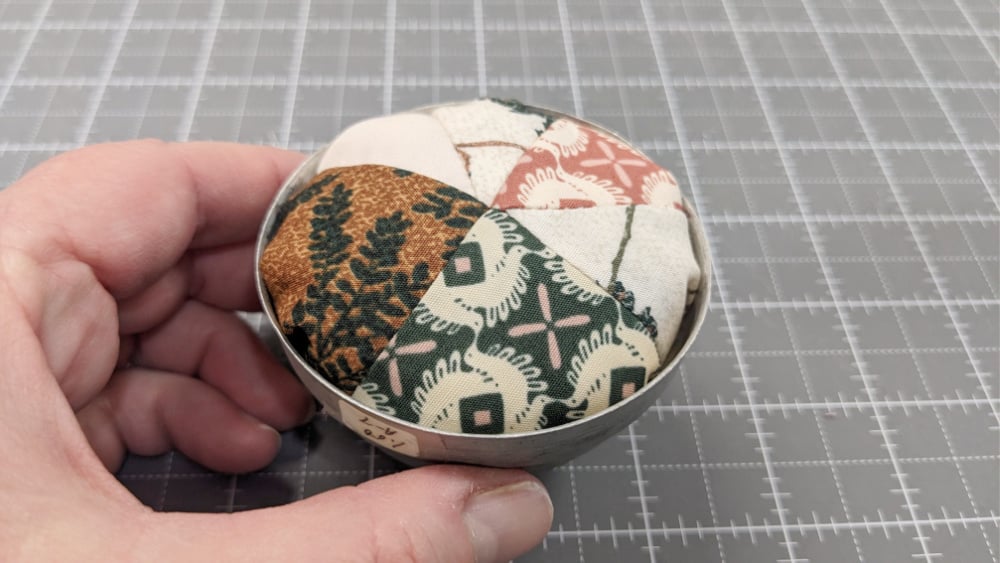Having the right needle for the right project is pretty important. Not having the correct size, etc can lead to broken thread, frustration and unfinished projects.
Learn which needle is right for your quilt project.
What Type of Needles are there
Needles range in size from a very thin and flexible 608 to a heavy-duty needle 120/19. (Needle sizes are not the same for regular home machines and commercial machines. So, double check before grabbing a big ol pile.)
Just like thread, most needles use a two number identification system to define the needle shaft diameter. The higher number measures the diameter in fractions of a millimeter.
The lower number is the numbering system used in the U.S. In sewing machine needle parlance, the smaller the number, the smaller the needle.
A 14/90 is larger than a 8/60.
Schmetz does have a color coding system. You can see the image below. Download it here.

You should always change your needle after 6 – 10 hours of sewing.
I’m not the best at this and tend to forget. What happens, which will remind me is that I start having broken thread or shredded thread. I can hear the needle punching through the fabric. Those are the hints that it’s time to change your needle.
There are eleven basic types of needles, but for quilting, we’ll only mention a few.
Before we go there, let’s get a few things cleared up:
Point Style – This refers to how the point of the needle is shaped and generally defines what type of needle it is.
Sizes – This refers to what size the needle comes in and defines what type or thickness of fabric it should be used with as well as the weight of thread being used.
Color Code – This is the color that you will find on the shaft of the needle to tell you what type of needle it is when not in the packaging.
Piecing – This is where you sew fabric pieces together to make the quilt top.
Quilting – Stitching through the three layers of quilt, top, batting, and backing to hold them all in place.
Needles for Quilters:

Universal Needle -this is a multi-purpose needle that is good for a variety of projects however this is not the one to handle lots of layers.
The point style is slightly rounded and does not have a color code.
It comes in quite a few sizes with the most commonly used being sizes 75/11, 80/12, 90/14.
Buy it here

Quilting Needle – This needle has a thin shaft and is designed for both piecing and machine quilting through the quilt sandwich (top, batting, binding).
The point style is slightly rounded with a tapered shaft that pierces through several layers of woven fabric at one time without damaging them.
It comes in sizes 75/11, 80/12, 90/14, and has a green color code stripe on the needle to identify it.
Buy it here.

Topstitching Needle – This needle has a long eye and a deep groove down the shaft that is designed to accommodate heavier threads or fabrics being used.
The point style is quite sharp and pointed.
It comes in sizes 80/12, 90/14, 100/16, and does not have a color code. The larger sizes will make bigger holes in the fabric, so be sure to use the right size thread with these needles.
Buy it here.

Microtex Sharp Needle – This needle has a thin shaft and sharp point that is used for fine wovens such as poplin cotton, voile, and lawn.
The point style is quite sharp and pointed and produces very nice stitches that are perfect for piecing.
It comes in sizes 60/8, 65/9, 70/10, 80/12, 90/14, and has a purple color code stripe. The thinner needle is more apt to break and should be changed more often. If the needle breaks often it is recommended to increase the needle size.
Buy it here.
As with any needle or thread for your sewing machine, you’ll want to check out your manual to make sure you are using the right needle or thread for that machine.
In the past, I’ve had a few threads go crazy. My machine simply didn’t like it. So give a few a try and find which one is best for not only the project but also your machine.

Becky Jorgensen is the creative quilter behind Patchwork Posse, the Patchwork Planner and her online quilt group Patchworkers Plus. You can find her patterns in books, magazines, and her quilt membership. Gather your quilting supplies, organize your sewing space, explore the process of disappearing quilt blocks, or finish a free quilt pattern. I'll help you use what you have, finish what you start and make your quilting journey fun!
Follow me here: Facebook, Pinterest, YouTube






